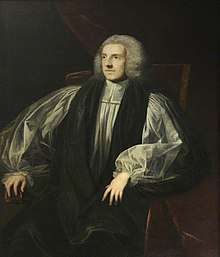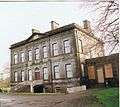Richard Robinson, 1st Baron Rokeby
Richard Robinson, 1st Baron Rokeby (1708 – 10 October 1794), was an Anglo-Irish churchman.
Richard Robinson D.D. | |
|---|---|
| Lord Primate of All Ireland Lord Archbishop of Armagh | |
 Lord Rokeby by Sir Joshua Reynolds | |
| Church | Church of Ireland |
| See | Armagh |
| Appointed | 8 February 1765 |
| In office | 1765-1794 |
| Predecessor | George Stone |
| Successor | William Newcome |
| Orders | |
| Consecration | 19 January 1752 by Charles Cobbe |
| Personal details | |
| Born | baptised 13 July 1708 |
| Died | 10 October 1794 (aged 86) Clifton, Bristol, England |
| Buried | St Patrick's Cathedral, Armagh |
| Nationality | English |
| Denomination | Anglican |
| Previous post | Bishop of Killala and Achonry (1751-1759) Bishop of Ferns and Leighlin (1759-1761) Bishop of Kildare (1761-1765) |
| Education | Westminster School |
| Alma mater | Christ Church, Oxford |
Life
He was educated at Westminster School and Christ Church, Oxford (BA 1730, MA 1733, BD & DD 1748).
Robinson came to Ireland as chaplain to the Duke of Dorset in 1751. He was translated from the See of Kildare to the Archbishopric of Armagh in 1765.
In 1777 he was created Baron Rokeby, of Armagh in the County of Armagh, in the Peerage of Ireland,[1] with special remainder to Matthew Robinson (1694–1778) of West Layton, in the North Riding of the county of Yorkshire, his second cousin, twice removed, who predeceased him.
In 1774 he founded the County Infirmary. In 1780 he donated land for the erection of a new prison and in 1771 he founded the Armagh Public Library.[2] In 1790 he founded the Armagh Observatory as part of his plan for a university in Armagh.
Archbishop Lord Rokeby died at Clifton in Bristol on 10 October 1794, and was buried in Armagh Cathedral. He was succeeded by Matthew Robinson, 2nd Baron Rokeby, the son of his second cousin Matthew Robinson, who inherited his titles, and was a noted eccentric.
There is a memorial to Robinson in the south aisle at St Patrick's Cathedral, Armagh.[3]
Reputation
Robert Walpole called Robinson 'a proud but superficial man'. John Wesley accused him of being more interested in buildings than in the care of souls.
Richard Cumberland described him as "splendid, liberal, lofty ... publicly ambitious of great deeds, and privately capable of good ones, ... he made no court to popularity by his manners but he benefited a whole nation by his public works."[4]
Architectural benefactor
The Canterbury Gate at Christ Church, Oxford, completed in 1873, is one monument to Archbishop Lord Rokeby's munificence. The gate is inscribed:
- MUNIFICENTIA ALUMNORUM PRAECIPUE RICARDI ROBINSON ARCHICEP. ARMAGH.
- (By the munificence of alumni, especially of Richard Robinson, Archbishop of Armagh.)
- The Canterbury Gate, Christ Church, Oxford.

 Robinson's Rokeby Hall, and its conservatory.
Robinson's Rokeby Hall, and its conservatory.
References
- "No. 11742". The London Gazette. 4 February 1777. p. 1.
- Armagh Public Library
- "Funary Monuments & Memorials in St Patrick's Cathedral, Armagh" Curl, J.S. pp71-77: Whitstable; Historical Publications; 2013 ISBN 978-1-905286-48-5
- Memoirs, volume 2, pps. 353-54, quoted from The Complete Peerage.
External links
| Church of Ireland titles | ||
|---|---|---|
| Preceded by Mordecai Cary |
Bishop of Killala and Achonry 1752–1759 |
Succeeded by Samuel Hutchinson |
| Preceded by Thomas Salmon |
Bishop of Ferns and Leighlin 1759–1761 |
Succeeded by Charles Jackson |
| Preceded by Thomas Fletcher |
Bishop of Kildare 1761–1765 |
Succeeded by Charles Jackson |
| Preceded by George Stone |
Archbishop of Armagh 1765–1794 |
Succeeded by William Newcome |
| Baronetage of England | ||
| Preceded by William Robinson |
Robinson baronets (of Rokeby Park) 1777–1794 |
Succeeded by Matthew Robinson |
| Peerage of Ireland | ||
| New creation | Baron Rokeby 1777–1794 |
Succeeded by Matthew Robinson |